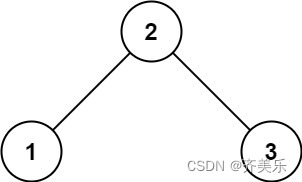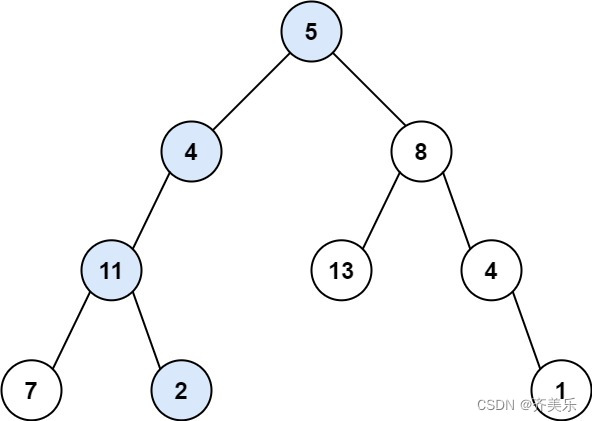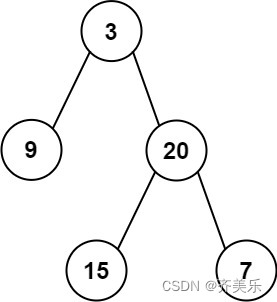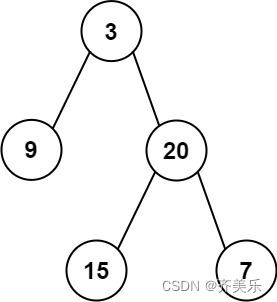513. 找树左下角的值
题目:给定一个二叉树的 根节点 root,请找出该二叉树的 最底层 最左边 节点的值。
假设二叉树中至少有一个节点。
示例 1:
输入: root = [2,1,3]
输出: 1
思路一:层序遍历,最后一层的第一个元素,即是树左下角的值。
思路二:通过递归,深度优先遍历原则,因为本题没有 中间节点的处理逻辑,所以使用前、中、后序遍历都可以,保证优先左边搜索,然后记录深度最大的叶子节点,此时就是树的最后一行最左边的值
思路一:层序遍历
C#代码
/*** Definition for a binary tree node.* public class TreeNode {* public int val;* public TreeNode left;* public TreeNode right;* public TreeNode(int val=0, TreeNode left=null, TreeNode right=null) {* this.val = val;* this.left = left;* this.right = right;* }* }*/
public class Solution {public int FindBottomLeftValue(TreeNode root) {var result = 0;if(root == null) return result;var queue = new Queue<TreeNode>();queue.Enqueue(root);while(queue.Any()){int len = queue.Count;var itemList = new Queue<int>();while(len>0){var temp = queue.Dequeue();itemList.Enqueue(temp.val);if(temp.left!=null) queue.Enqueue(temp.left);if(temp.right!=null) queue.Enqueue(temp.right);len--;}result = itemList.Dequeue();}return result;}
}
思路二:递归
C#代码
/*** Definition for a binary tree node.* public class TreeNode {* public int val;* public TreeNode left;* public TreeNode right;* public TreeNode(int val=0, TreeNode left=null, TreeNode right=null) {* this.val = val;* this.left = left;* this.right = right;* }* }*/
public class Solution {//结果值int result = 0;//最大深度int maxDepth = -1;public int FindBottomLeftValue(TreeNode root) {Traversal(root,1);return result;}// 1. 确定返回值和参数public void Traversal(TreeNode node,int depth){//2. 确定终止条件if(node.left==null&&node.right== null){//叶子节点if(depth>maxDepth){//当前深度大于最大深度maxDepth = depth;//记录当前深度为最大深度result = node.val;}}//找左下角的值所以优先遍历左左子树if(node.left!=null){depth++;Traversal(node.left,depth);//回溯深度的值depth--;//精简代码 traversal(root->left, depth + 1); 隐藏着回溯}//遍历右子树if(node.right!=null){depth++;Traversal(node.right,depth);depth--;}}
}
112. 路径总和
题目:给你二叉树的根节点 root 和一个表示目标和的整数 targetSum 。判断该树中是否存在 根节点到叶子节点 的路径,这条路径上所有节点值相加等于目标和 targetSum 。如果存在,返回 true ;否则,返回 false 。
叶子节点 是指没有子节点的节点。
示例一:
输入:root = [5,4,8,11,null,13,4,7,2,null,null,null,1], targetSum = 22
输出:true
解释:等于目标和的根节点到叶节点路径如上图所示。
思路:可以使用深度优先遍历的方式(本题前中后序都可以,无所谓,因为中节点也没有处理逻辑)来遍历二叉树
C#代码:
/*** Definition for a binary tree node.* public class TreeNode {* public int val;* public TreeNode left;* public TreeNode right;* public TreeNode(int val=0, TreeNode left=null, TreeNode right=null) {* this.val = val;* this.left = left;* this.right = right;* }* }*/
public class Solution {public bool HasPathSum(TreeNode root, int targetSum) {if(root == null) return false;targetSum -= root.val;//确定终止条件if(root.left == null && root.right == null){return targetSum == 0;}if(root.left!=null){if(HasPathSum(root.left,targetSum)) return true;}if(root.right!=null){if(HasPathSum(root.right,targetSum)) return true;}return false;}
}
113. 路径总和 II
题目:给你二叉树的根节点 root 和一个整数目标和 targetSum ,找出所有 从根节点到叶子节点 路径总和等于给定目标和的路径。
叶子节点 是指没有子节点的节点。
示例一:
输入:root = [5,4,8,11,null,13,4,7,2,null,null,5,1], targetSum = 22
输出:[[5,4,11,2],[5,8,4,5]]
C#代码:
public class Solution {List<IList<int>> result = new List<IList<int>>();public IList<IList<int>> PathSum(TreeNode root, int targetSum) {var list = new List<int>();Traversal(root,targetSum,list);return result;}public void Traversal(TreeNode root, int targetSum,List<int> list){if(root == null) return;list.Add(root.val);targetSum -= root.val;//到达叶子节点并且路径正确if(root.left==null&&root.right==null&&targetSum==0){result.Add(new List<int>(list.ToArray()));return;}if(root.left!=null){Traversal(root.left,targetSum,list);//回溯list.RemoveAt(list.Count - 1);}if(root.right!=null){Traversal(root.right,targetSum,list);//回溯list.RemoveAt(list.Count - 1);}}
}
106. 从中序与后序遍历序列构造二叉树
题目:给定两个整数数组 inorder 和 postorder ,其中 inorder 是二叉树的中序遍历, postorder 是同一棵树的后序遍历,请你构造并返回这颗 二叉树 。
示例一:
输入:inorder = [9,3,15,20,7], postorder = [9,15,7,20,3]
输出:[3,9,20,null,null,15,7]
思路:
- 通过后序序列可以知道最后一个元素为根结点。
- 知道根结点后,通过中序序列可以判断出根结点的左右子树。
解题过程:
- 第一步:如果数组大小为零的话,说明是空节点了。
- 第二步:如果不为空,那么取后序数组最后一个元素作为节点元素。
- 第三步:找到后序数组最后一个元素在中序数组的位置,作为切割点
- 第四步:切割中序数组,切成中序左数组和中序右数组 (顺序别搞反了,一定是先切中序数组)
- 第五步:切割后序数组,切成后序左数组和后序右数组
- 第六步:递归处理左区间和右区间
C#代码,递归
public class Solution {public TreeNode BuildTree(int[] inorder, int[] postorder) {// 1. 如果后序数组元素为0,则为空树if(postorder.Length==0) return null;// 2. 取后序序列的最后一个元素,得到根结点int rootVale = postorder[postorder.Length - 1];TreeNode node = new TreeNode(rootVale);if(postorder.Length == 1) return node;// 3. 通过根结点找到中序序列的分割点下标int index;for(index = 0; index<inorder.Length; index++){if(inorder[index] == rootVale){break;}}// 4. 分割左子树//左子树的中序序列int[] leftInorder = new int[index];//遍历拷贝// for(int i = 0;i<leftInorder.Length;i++){// leftInorder[i] = inorder[i];// }//使用Array.Copy方法Array.Copy(inorder,0,leftInorder,0,leftInorder.Length);int[] leftPostorder = new int[leftInorder.Length];// for(int i= 0; i<leftPostorder.Length;i++){// leftPostorder[i] = postorder[i];// }Array.Copy(postorder,0,leftPostorder,0,leftPostorder.Length);// 5. 分割右子树//右子树的中序序列int[] rightInorder = new int[inorder.Length -(index+1)];// for(int i = 0;i<rightInorder.Length;i++){// rightInorder[i] = inorder[i+index+1];// }Array.Copy(inorder,index+1,rightInorder,0,rightInorder.Length);int[] rightPostorder = new int[rightInorder.Length];// for(int i = 0;i<rightPostorder.Length;i++){// rightPostorder[i] = postorder[i+leftPostorder.Length];// }Array.Copy(postorder,leftPostorder.Length,rightPostorder,0,rightPostorder.Length);// 6. 递归左区间和右区间node.left = BuildTree(leftInorder,leftPostorder);node.right = BuildTree(rightInorder,rightPostorder);return node;}
}
105. 从前序与中序遍历序列构造二叉树
题目:给定两个整数数组 preorder 和 inorder ,其中 preorder 是二叉树的先序遍历, inorder 是同一棵树的中序遍历,请构造二叉树并返回其根节点。
示例一:
输入: preorder = [3,9,20,15,7], inorder = [9,3,15,20,7]
输出: [3,9,20,null,null,15,7]
思路和后序遍历一样,通过前序遍历的第一个元素可知根结点,通过根结点和中序序列,分割出左右子树,通过递归即可构建出二叉树。
C#代码:
public class Solution {public TreeNode BuildTree(int[] preorder, int[] inorder) {//1. 判断前序遍历长度if(preorder.Length == 0) return null;//2. 获取根结点int rootVale = preorder[0];TreeNode root = new TreeNode(rootVale);if(preorder.Length == 1) return root;//3. 获取根结点在中序序列中的下标int index;for(index = 0;index<inorder.Length;index++){if(inorder[index] == rootVale){break;}}//4. 分割左子树int[] leftInorder = new int[index];Array.Copy(inorder,0,leftInorder,0,index);int[] leftPreorder = new int[leftInorder.Length];Array.Copy(preorder,1,leftPreorder,0,leftPreorder.Length);//5. 分割右子树int[] rightInorder = new int[inorder.Length -(index+1)];Array.Copy(inorder,index+1,rightInorder,0,rightInorder.Length);int[] rigthPreorder = new int[rightInorder.Length];Array.Copy(preorder,1+leftPreorder.Length,rigthPreorder,0,rigthPreorder.Length);//6. 递归左区间和右区间root.left = BuildTree(leftPreorder,leftInorder);root.right = BuildTree(rigthPreorder,rightInorder);return root;}
}

:栈与队列)

)
)
)


![[SICTF 2023 #Round2] Crypto,PWN,Reverse](http://pic.xiahunao.cn/[SICTF 2023 #Round2] Crypto,PWN,Reverse)

:轮廓外接最大、最小矩形和多边形拟合)

![Go语言的[GPM模型]](http://pic.xiahunao.cn/Go语言的[GPM模型])





